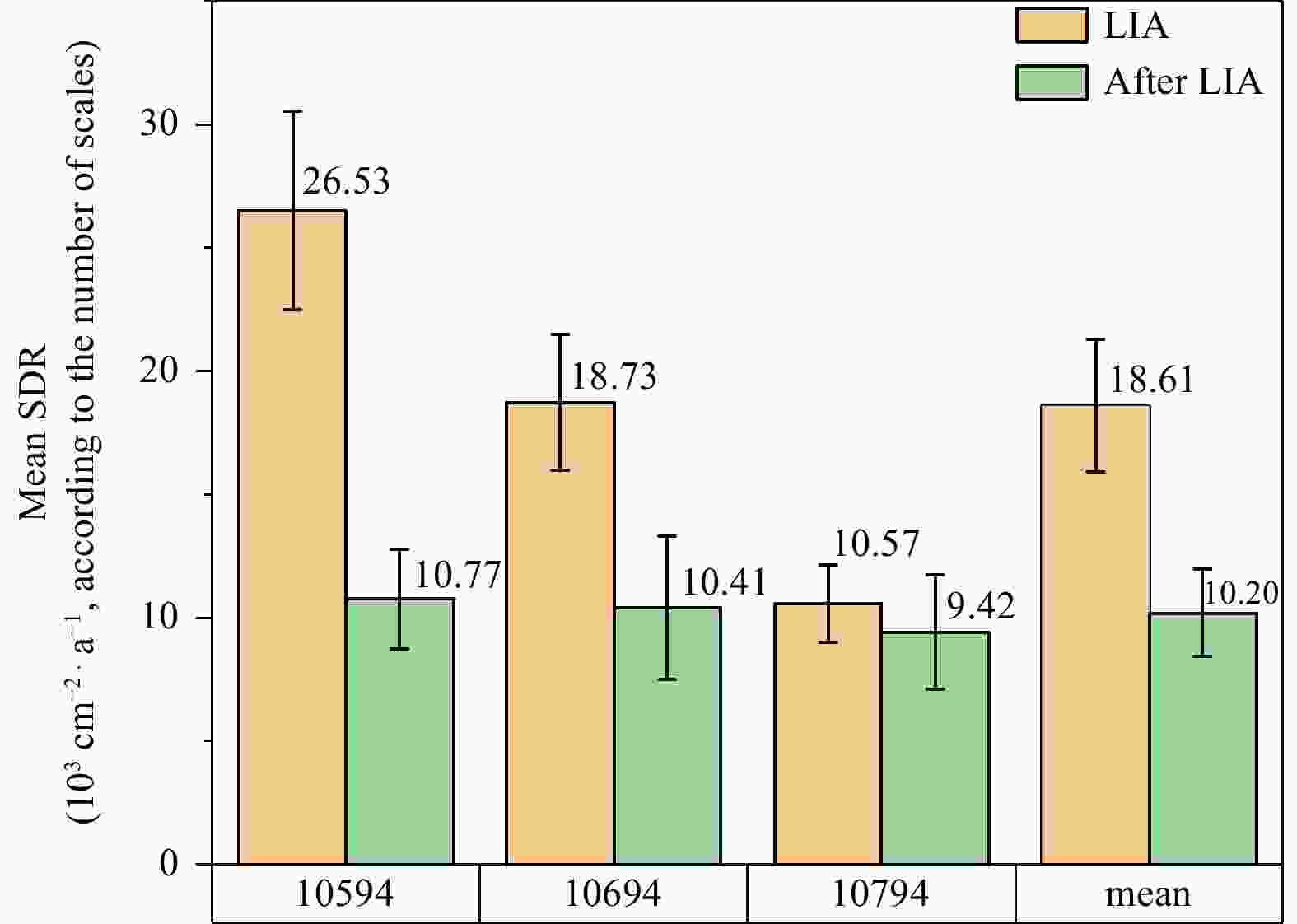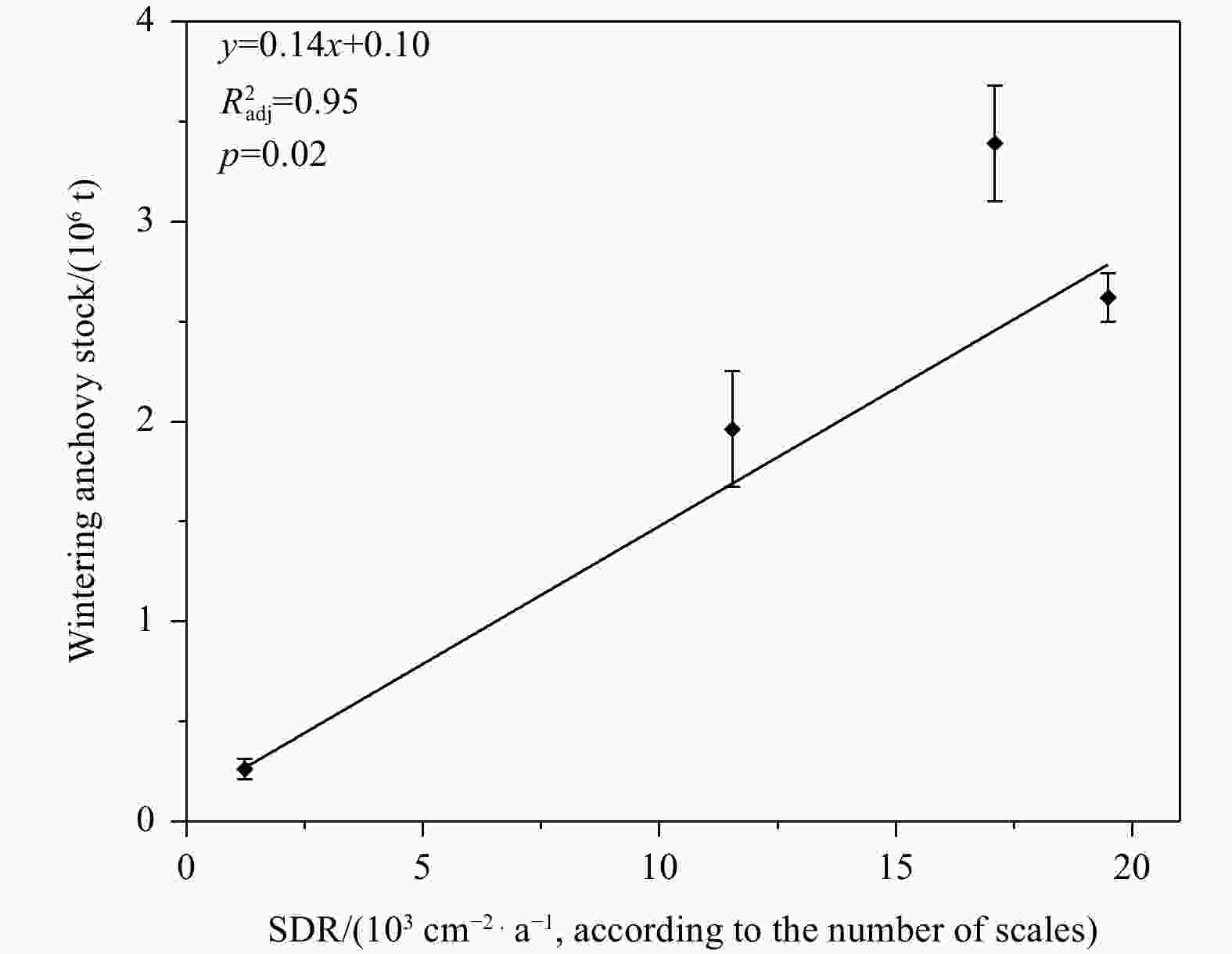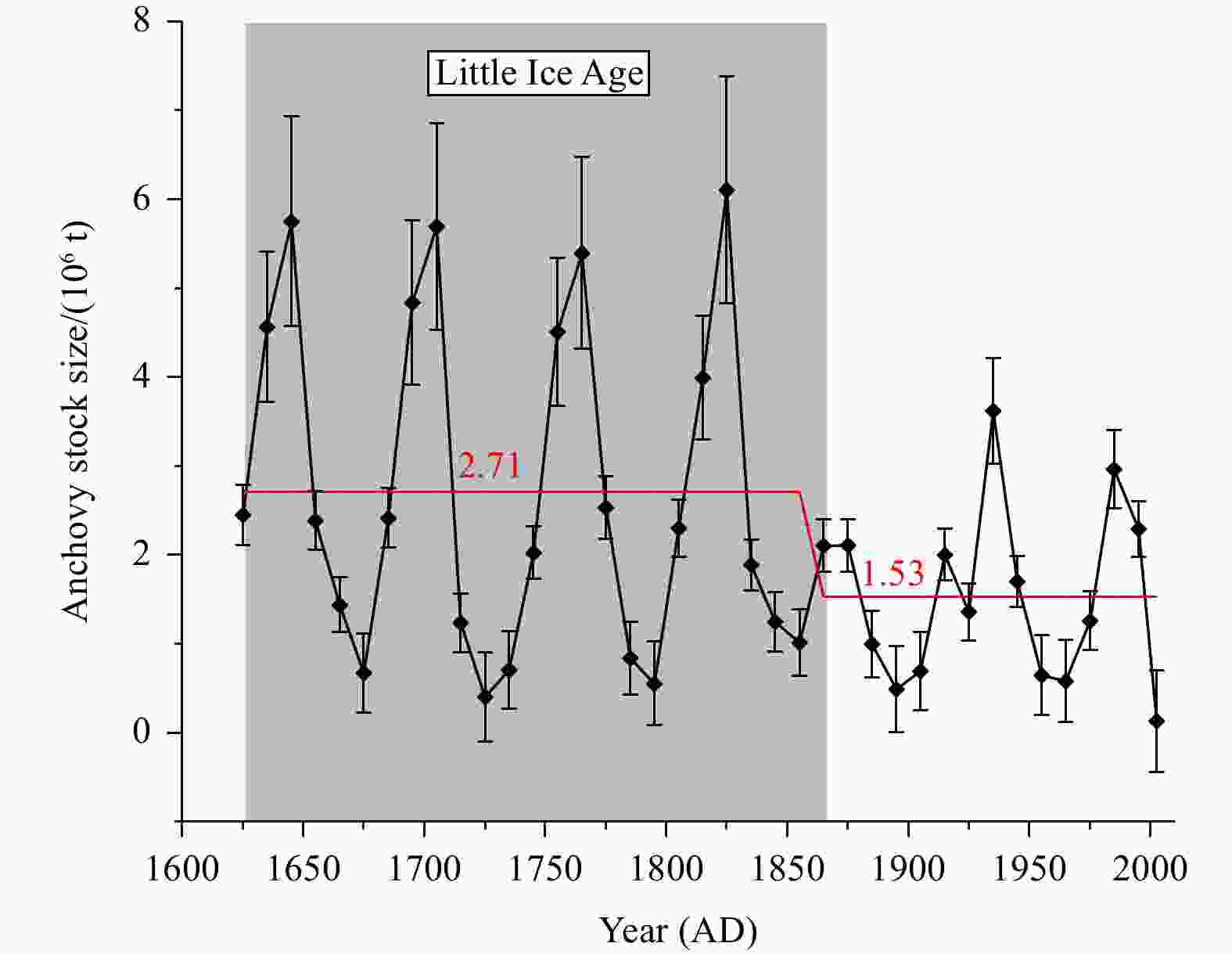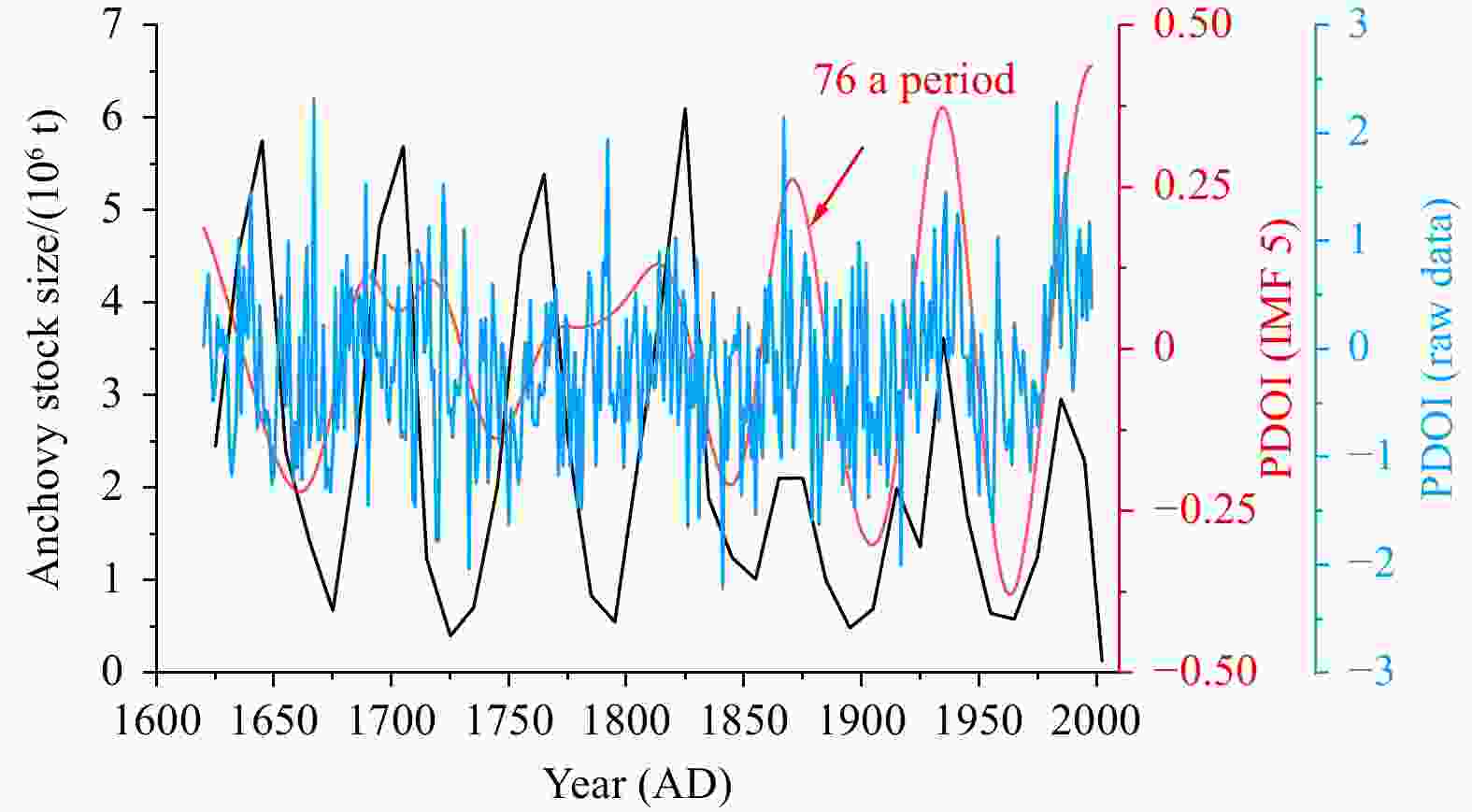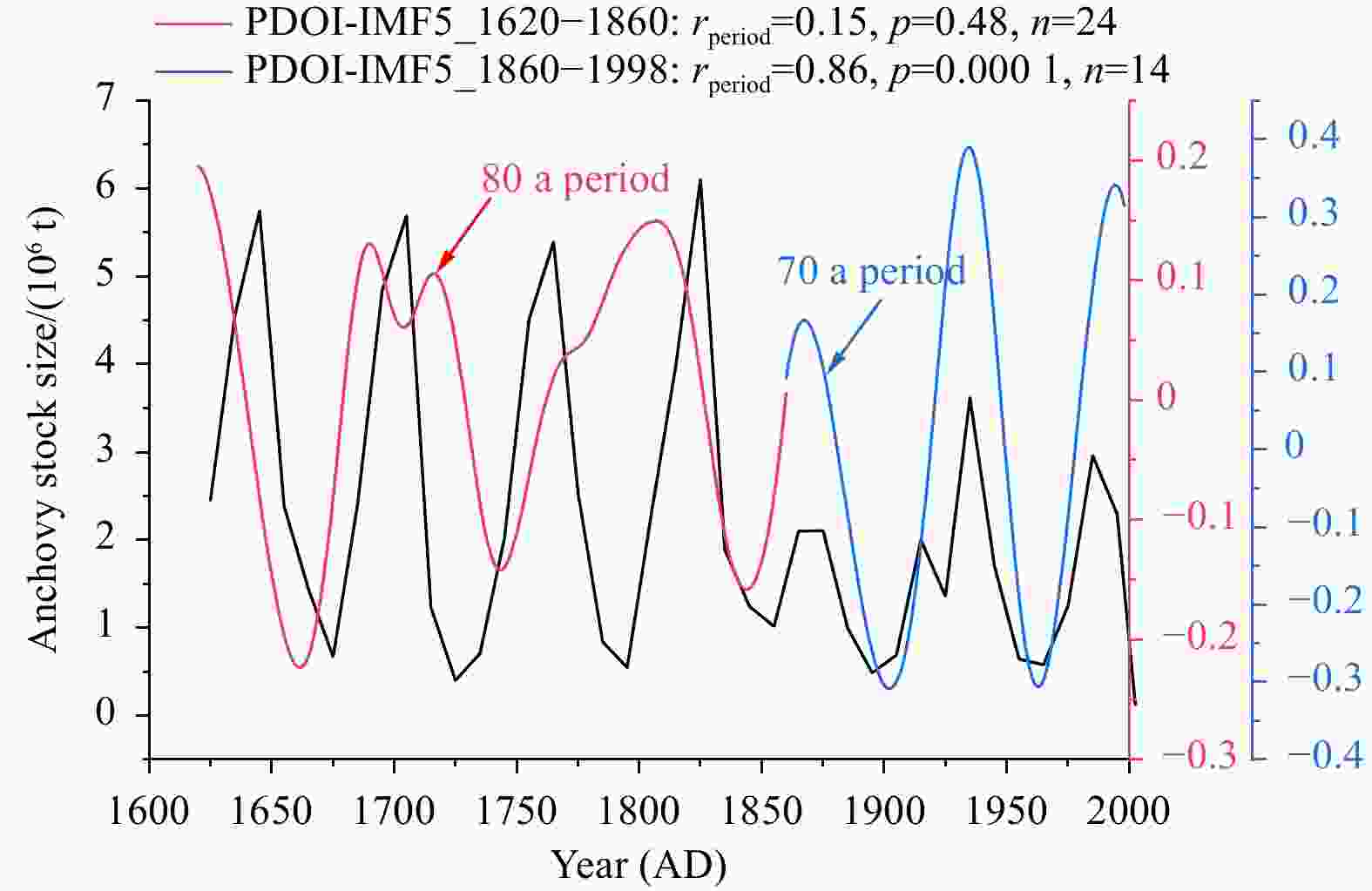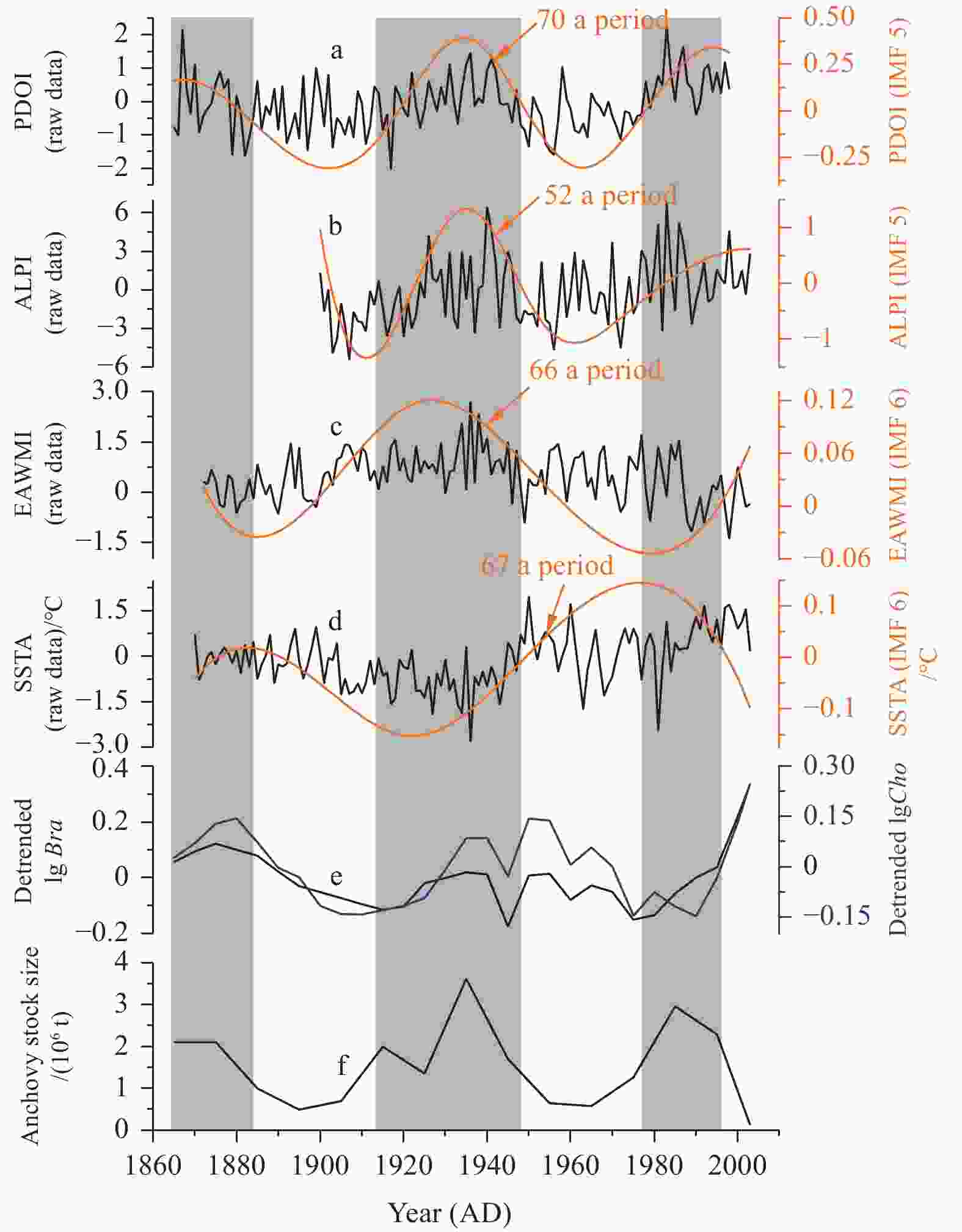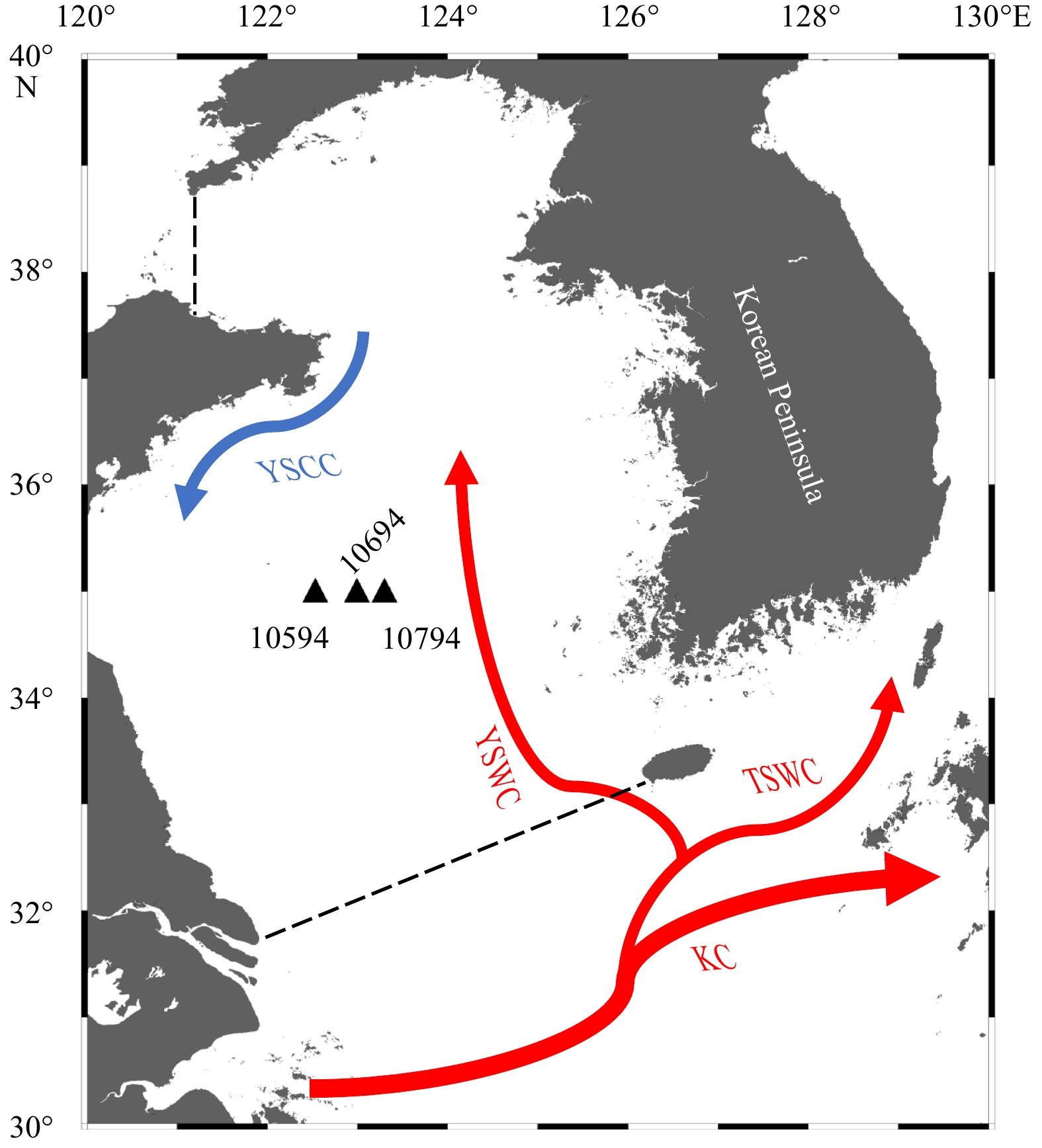Response of Japanese anchovy (Engraulis japonicus) to the Pacific Decadal Oscillation in the Yellow Sea over the past 400 a
-
Abstract: Quantitative identification of long-term changes in the abundance of Japanese anchovy (Engraulis japonicus) in the Yellow Sea is particularly important for understanding evolutionary processes of the Yellow Sea ecosystem. Unfortunately, the driving mechanisms of climate variability on the anchovy are still unclear due to the lack of long-term observational data. In this study, we used the fish scale deposition rate in the central Yellow Sea to reconstruct the time series of the anchovy stock over the past 400 a. On this basis, we further explored the impacts of the Pacific Decadal Oscillation (PDO) on the anchovy. Our results show that the anchovy stock is positively correlated with the PDO on a decadal time scale. In addition, anchovy abundance was relatively high during 1620–1860 AD (the Little Ice Age, LIA), though in a state of constant fluctuation; anchovy abundance maintained at a relatively low level after ~1860 AD. In particular, followed by overfishing since the 1980s, the anchovy stock has declined sharply. Based on these findings, we infer that fluctuations of the anchovy stock may be regulated by basin-scale “atmosphere–ocean” interactions. Nevertheless, the role of overfishing should not be ignored.
-
Figure 1. The map of the study area in the Yellow Sea. Arrows with solid lines represent the ocean currents; warm currents (red) include Kuroshio Current (KC), Tsushima Warm Current (TSWC), and Yellow Sea Warm Current (YSWC); cold current (blue) is Yellow Sea Coastal Current (YSCC). Black triangles show the sampling Sites 10594, 10694 and 10794. Black dashed lines show boundaries between seas.
Figure 4. The relationship between the wintering anchovy stock estimated from acoustic investigations (Jin et al., 2001; Zhao, 2006) and fish scale deposition rate (SDR) in sediment cores in the Yellow Sea from 1985 AD to 2005 AD. The straight line is the fitted linear regression between the wintering anchovy stock and the SDR and was used to reconstruct the historical anchovy stock.
Figure 6. Relationship of the reconstructed anchovy stock in the Yellow Sea with the Pacific Decadal Oscillation index (PDOI) (data were obtained from Shen et al. (2006)). The fifth Intrinsic Mode Function (IMF 5) with 76 a period by Ensemble Empirical Mode Decomposition during the 1620–1998 AD (red vertical axis) was used (r=0.29, p=0.07, n=38). The raw data of PDOI during 1620–1998 AD were adopted.
Figure 7. Relationship of the reconstructed anchovy stock in the Yellow Sea with the Pacific Decadal Oscillation index (PDOI) (data were obtained from Shen et al. (2006)). The fifth Intrinsic Mode Function (IMF 5) with 80 a and 70 a period by Ensemble Empirical Mode Decomposition during the Little Ice Age (LIA) (1620−1860 AD) and after the LIA (1860-1998 AD) was used, respectively.
Figure 8. Comparison of the reconstructed anchovy stock with environmental variables in the Yellow Sea. a. The data of Pacific Decadal Oscillation index (PDOI) were obtained from Shen et al. (2006); b. the Aleutian Low Pressure index (ALPI) from Surry and King (2015); c. the East Asian Winter Monsoon index (EAWMI) from Zhang et al. (2013); d. the winter (average in January–March) sea surface temperature anomaly (SSTA) with a resolution of 1°×1° (latitude×longitude) for the range 32°–37°N, 120°–125°E from Rayner et al. (2006).; e. the data of biomarkers in the Core 10694 from Xing et al. (2009). The orange lines indicate the selected Intrinsic Mode Functions (IMFs) with different periods by Ensemble Empirical Mode Decomposition. The brassicasterol content (Bra) could be used to represent diatom productivity (primary productivity), and the cholesterol content (Cho) for zooplankton abundance (secondary productivity). The gray rectangles represent periods when the anchovy stock dominated.
Figure 9. Schematic illustrating the potential “atmosphere–ocean” pattern based on a bottom-up hypothesis for anchovy stock in the Yellow Sea. Closed and open arrows indicate direct and indirect effects, respectively. PDO is the abbreviation of Pacific Decadal Oscillation; ALP, Aleutian Low Pressure; EAWM, East Asian Winter Monsoon; SST, sea surface temperature; MLD, mixed layer depth.
Table 1. Spearman’s correlation coefficients in scale deposition rate between sites of the Yellow Sea from 1620 AD to 2005 AD (n=39)
Site 10694 10794 10594 0.66**** 0.63**** 10694 0.58*** Note: Statistically significant correlations are indicated: ***, p<0.001; ****, p<0.000 1. Table 2. Pearson’s correlation coefficients between anchovy stock, climate variables and biogeochemical proxies from 1860 AD to 1950 AD (n=10)
PDOI
(IMF 5)ALPI
(IMF 5)EAWMI
(IMF 6)SSTA
(IMF 6)Detrended
lgBraDetrended
lgChoAnchovy stock 0.81** 0.68 0.52 −0.29 0.18 0.47 PDOI (IMF 5) 0.98** 0.57 −0.26 0.20 0.46 ALPI (IMF 5) 0.65 0.11 0.26 0.82 EAWMI (IMF 6) −0.90** −0.49 −0.44 SSTA (IMF 6) 0.41 0.63 Detrended lgBra 0.75* Note: PDOI is abbreviation of Pacific Decadal Oscillation index; ALPI, Aleutian Low Pressure index; EAWMI, East Asian Winter Monsoon index; SSTA, sea surface temperature anomaly. Bra represents brassicasterol content; Cho, cholesterol content. IMF n, nth Intrinsic Mode Function by Ensemble Empirical Mode Decomposition. Statistically significant correlations are indicated: *, p<0.05; **, p<0.01. -
[1] Alheit J, Niquen M. 2004. Regime shifts in the Humboldt Current ecosystem. Progress in Oceanography, 60(2–4): 201–222. doi: 10.1016/j.pocean.2004.02.006 [2] Alheit J, Pohlmann T, Casini M, et al. 2012. Climate variability drives anchovies and sardines into the North and Baltic Seas. Progress in Oceanography, 96(1): 128–139. doi: 10.1016/j.pocean.2011.11.015 [3] Baumgartner T R, Soutar A, Ferreira-Bartrina V. 1992. Reconstruction of the history of Pacific sardine and northern anchovy populations over the past two millennia from sediments of the Santa Barbara Basin, California. CalCOFI Reports, 33: 24–40 [4] Behrenfeld M J, O’Malley R T, Siegel D A, et al. 2006. Climate-driven trends in contemporary ocean productivity. Nature, 444(7120): 752–755. doi: 10.1038/nature05317 [5] Britten G L, Dowd M, Worm B. 2016. Changing recruitment capacity in global fish stocks. Proceedings of the National Academy of Sciences of the United States of America, 113(1): 134–139. doi: 10.1073/pnas.1504709112 [6] Capuzzo E, Lynam C P, Barry J, et al. 2018. A decline in primary production in the North Sea over 25 years, associated with reductions in zooplankton abundance and fish stock recruitment. Global Change Biology, 24(1): e352–e364. doi: 10.1111/gcb.13916 [7] Chavez F P, Ryan J, Lluch-Cota S E, et al. 2003. From anchovies to sardines and back: multidecadal change in the Pacific Ocean. Science, 299(5604): 217–221. doi: 10.1126/science.1075880 [8] Checkley D M, Asch R G, Rykaczewski R R. 2017. Climate, anchovy, and sardine. Annual Review of Marine Science, 9: 469–493. doi: 10.1146/annurev-marine-122414-033819 [9] Cury P, Shannon L. 2004. Regime shifts in upwelling ecosystems: observed changes and possible mechanisms in the northern and southern Benguela. Progress in Oceanography, 60(2–4): 223–243. doi: 10.1016/j.pocean.2004.02.007 [10] Deyle E R, Fogarty M, Hsieh C H, et al. 2013. Predicting climate effects on Pacific sardine. Proceedings of the National Academy of Sciences of the United States of America, 110(16): 6430–6435. doi: 10.1073/pnas.1215506110 [11] Doney S C, Ruckelshaus M, Duffy J E, et al. 2012. Climate change impacts on marine ecosystems. Annual Review of Marine Science, 4: 11–37. doi: 10.1146/annurev-marine-041911-111611 [12] Frank K T, Petrie B, Choi J S, et al. 2005. Trophic cascades in a formerly cod-dominated ecosystem. Science, 308(5728): 1621–1623. doi: 10.1126/science.1113075 [13] Greene C H, Pershing A J. 2007. Climate drives sea change. Science, 315(5815): 1084–1085. doi: 10.1126/science.1136495 [14] Guiñez M, Valdés J, Sifeddine A, et al. 2014. Anchovy population and ocean-climatic fluctuations in the Humboldt Current System during the last 700 years and their implications. Palaeogeography, Palaeoclimatology, Palaeoecology, 415: 210–224 [15] Gutiérrez D, Sifeddine A, Field D B, et al. 2009. Rapid reorganization in ocean biogeochemistry off Peru towards the end of the Little Ice Age. Biogeosciences, 6(5): 835–848. doi: 10.5194/bg-6-835-2009 [16] Holmgren D. 2001. Decadal-centennial variability in marine ecosystems of the Northeast Pacific Ocean: the use of fish scales depositions in sediments [dissertation]. Washington: University of Washington [17] Holmgren-Urba D, Baumgartner T R. 1993. A 250-year history of pelagic fish abundances from the anaerobic sediments of the central Gulf of California. CalCOFI Reports, 34: 60–68 [18] Hsieh C H, Reiss C S, Hunter J R, et al. 2006. Fishing elevates variability in the abundance of exploited species. Nature, 443(7113): 859–862. doi: 10.1038/nature05232 [19] Hu Bangqi, Yang Zuosheng, Zhao Meixun, et al. 2012. Grain size records reveal variability of the East Asian Winter Monsoon since the Middle Holocene in the Central Yellow Sea mud area, China. Science China: Earth Sciences, 55(10): 1656–1668. doi: 10.1007/s11430-012-4447-7 [20] Huang Jiansheng, 2015. Sedimentary record of anchovy population dynamics in the Yellow Sea and its response to climate changes (in Chinese) [dissertation]. Xiamen: Xiamen University [21] Huang Jiansheng, Sun Yao, Jia Haibo, et al. 2014. Spatial distribution and reconstruction potential of Japanese anchovy (Engraulis japonicus) based on scale deposition records in recent anaerobic sediment of the Yellow Sea and East China Sea. Acta Oceanologica Sinica, 33(12): 138–144. doi: 10.1007/s13131-014-0573-8 [22] Huang Jiansheng, Sun Yao, Jia Haibo, et al. 2016. Last 150-year variability in Japanese anchovy (Engraulis japonicus) abundance based on the anaerobic sediments of the Yellow Sea Basin in the western North Pacific. Journal of Ocean University of China, 15(1): 131–136. doi: 10.1007/s11802-016-2605-9 [23] Izquierdo-Peña V, Lluch-Cota S E, Hernandez-Rivas M E, et al. 2019. Revisiting the regime problem hypothesis: 25 years later. Deep-Sea Research Part II: Topical Studies in Oceanography, 159: 4–10. doi: 10.1016/j.dsr2.2018.11.003 [24] Jacox M G, Bograd S J, Hazen E L, et al. 2015. Sensitivity of the California Current nutrient supply to wind, heat, and remote ocean forcing. Geophysical Research Letters, 42(14): 5950–5957. doi: 10.1002/2015GL065147 [25] Jang C J, Park J, Park T, et al. 2011. Response of the ocean mixed layer depth to global warming and its impact on primary production: a case for the North Pacific Ocean. ICES Journal of Marine Science, 68(6): 996–1007. doi: 10.1093/icesjms/fsr064 [26] Jia Haibo, Sun Yao, Zhao Meixun, et al. 2008. Fish-scale-deposition information and spatial distribution in typical fishery area of the Yellow Sea and East China Sea. Journal of Fisheries of China, 32(4): 584–591 [27] Jin Xianshi, Hamre J, Zhao Xianyong, et al. 2001. Study on the quota management of anchovy (Engraulis japonicus) in the Yellow Sea. Journal of Fishery Sciences of China, 8(3): 27–30 [28] Jin Xianshi, Zhang Bo, Xue Ying. 2010. The response of the diets of four carnivorous fishes to variations in the Yellow Sea ecosystem. Deep-Sea Research Part II: Topical Studies in Oceanography, 57(11–12): 996–1000. doi: 10.1016/j.dsr2.2010.02.001 [29] Kawasaki T. 2002. Climate change, regime shift and stock management. Fisheries Science, 68(S1): 148–153 [30] Kim D, Park B K, Shin I C. 1998. Paleoenvironmental changes of the Yellow Sea during the Late Quaternary. Geo-Marine Letters, 18(3): 189–194. doi: 10.1007/s003670050067 [31] Kuparinen A, Boit A, Valdovinos F S, et al. 2016. Fishing-induced life-history changes degrade and destabilize harvested ecosystems. Scientific Reports, 6(1): 22245. doi: 10.1038/srep22245 [32] Kuwae M, Yamamoto M, Sagawa T, et al. 2017. Multidecadal, centennial, and millennial variability in sardine and anchovy abundances in the western North Pacific and climate–fish linkages during the late Holocene. Progress in Oceanography, 159: 86–98. doi: 10.1016/j.pocean.2017.09.011 [33] Li Haoyu, Yang Shu, Tang Qisheng, et al. 2020. Long-term variation in the abundance of Pacific herring (Clupea pallasii) from the Yellow Sea in the western North Pacific and its relation to climate over the past 590 years. Fisheries Oceanography, 29(1): 56–65. doi: 10.1111/fog.12449 [34] Lindegren M, Checkley Jr D M, Rouyer T, et al. 2013. Climate, fishing, and fluctuations of sardine and anchovy in the California Current. Proceedings of the National Academy of Sciences of the United States of America, 110(33): 13672–13677. doi: 10.1073/pnas.1305733110 [35] Lindegren M, Van Deurs M, MacKenzie B R, et al. 2018. Productivity and recovery of forage fish under climate change and fishing: North Sea sandeel as a case study. Fisheries Oceanography, 27(3): 212–221. doi: 10.1111/fog.12246 [36] Litzow M A, Malick M J, Bond N A, et al. 2020. Quantifying a novel climate through changes in PDO-climate and PDO-salmon relationships. Geophysical Research Letters, 47(16): e2020GL087972 [37] Liu Yi, Zhou Xin, Huang Wen, et al. 2013. Responses of primary productivity to current and climate changes in the mud area to the Southwest of Cheju Island during the past 800 years. Journal of Ocean University of China, 12(4): 605–610. doi: 10.1007/s11802-013-2205-x [38] Ma Shuyang, Liu Yang, Li Jianchao, et al. 2019. Climate-induced long-term variations in ecosystem structure and atmosphere-ocean-ecosystem processes in the Yellow Sea and East China Sea. Progress in Oceanography, 175: 183–197. doi: 10.1016/j.pocean.2019.04.008 [39] Mantua N J, Hare S R. 2002. The Pacific Decadal Oscillation. Journal of Oceanography, 58(1): 35–44. doi: 10.1023/A:1015820616384 [40] Mantua N J, Hare R S, Zhang Yuan, et al. 1997. A Pacific interdecadal climate oscillation with impacts on salmon production. Bulletin of the American Meteorological Society, 78(6): 1069–1080. doi: 10.1175/1520-0477(1997)078<1069:APICOW>2.0.CO;2 [41] McClatchie S, Hendy I L, Thompson A R, et al. 2017. Collapse and recovery of forage fish populations prior to commercial exploitation. Geophysical Research Letters, 44(4): 1877–1885. doi: 10.1002/2016GL071751 [42] Mcowen C J, Cheung W W L, Rykaczewski R R, et al. 2015. Is fisheries production within large marine ecosystems determined by bottom-up or top-down forcing?. Fish and Fisheries, 16(4): 623–632. doi: 10.1111/faf.12082 [43] Möllmann C, Müller-Karulis B, Kornilovs G, et al. 2008. Effects of climate and overfishing on zooplankton dynamics and ecosystem structure: regime shifts, trophic cascade, and feedback loops in a simple ecosystem. ICES Journal of Marine Science, 65(3): 302–310. doi: 10.1093/icesjms/fsm197 [44] Newman M, Alexander M A, Ault T R, et al. 2016. The Pacific Decadal Oscillation, revisited. Journal of Climate, 29(12): 4399–4427. doi: 10.1175/JCLI-D-15-0508.1 [45] Oozeki Y, Ñiquen Carranza M, Takasuka A, et al. 2019. Synchronous multi-species alternations between the northern Humboldt and Kuroshio Current systems. Deep-Sea Research Part II: Topical Studies in Oceanography, 159: 11–21. doi: 10.1016/j.dsr2.2018.11.018 [46] Patterson R T, Prokoph A, Kumar A, et al. 2005. Late Holocene variability in pelagic fish scales and dinoflagellate cysts along the west coast of Vancouver Island, NE Pacific Ocean. Marine Micropaleontology, 55(3-4): 183–204. doi: 10.1016/j.marmicro.2005.02.006 [47] Pikitch E K, Rountos K J, Essington T E, et al. 2014. The global contribution of forage fish to marine fisheries and ecosystems. Fish and Fisheries, 15(1): 43–64. doi: 10.1111/faf.12004 [48] Pinsky M L, Byler D. 2015. Fishing, fast growth and climate variability increase the risk of collapse. Proceedings of the Royal Society B:Biological Sciences, 282(1813): 20151053. doi: 10.1098/rspb.2015.1053 [49] Pitois S G, Lynam C P, Jansen T, et al. 2012. Bottom-up effects of climate on fish populations: data from the Continuous Plankton Recorder. Marine Ecology Progress Series, 456: 169–186. doi: 10.3354/meps09710 [50] Planque B, Fromentin J M, Cury P, et al. 2010. How does fishing alter marine populations and ecosystems sensitivity to climate?. Journal of Marine Systems, 79(3-4): 403–417. doi: 10.1016/j.jmarsys.2008.12.018 [51] Qiao Shuqing, Shi Xuefa, Wang Guoqing, et al. 2017. Sediment accumulation and budget in the Bohai Sea, Yellow Sea and East China Sea. Marine Geology, 390: 270–281. doi: 10.1016/j.margeo.2017.06.004 [52] Rayner N A, Brohan P, Parker D E, et al. 2006. Improved analyses of changes and uncertainties in sea surface temperature measured in situ since the mid-nineteenth century: The HadSST2 dataset. Journal of Climate, 19(3): 446–469. doi: 10.1175/JCLI3637.1 [53] Roemmich D, McGowan J. 1995. Climatic warming and the decline of zooplankton in the California Current. Science, 267(5202): 1324–1326. doi: 10.1126/science.267.5202.1324 [54] Rykaczewski R R, Dunne J P. 2010. Enhanced nutrient supply to the California Current Ecosystem with global warming and increased stratification in an earth system model. Geophysical Research Letters, 37(21): L21606 [55] Salvatteci R, Field D, Baumgartner T, et al. 2012. Evaluating fish scale preservation in sediment records from the oxygen minimum zone off Peru. Paleobiology, 38(1): 52–78. doi: 10.1666/10045.1 [56] Salvatteci R, Field D, Gutiérrez D, et al. 2018. Multifarious anchovy and sardine regimes in the Humboldt Current System during the last 150 years. Global Change Biology, 24(3): 1055–1068. doi: 10.1111/gcb.13991 [57] Salvatteci R, Gutierrez D, Field D, et al. 2019. Fish debris in sediments from the last 25 kyr in the Humboldt Current reveal the role of productivity and oxygen on small pelagic fishes. Progress in Oceanography, 176: 102114. doi: 10.1016/j.pocean.2019.05.006 [58] Shen Gongming, Heino M. 2014. An overview of marine fisheries management in China. Marine Policy, 44: 265–272. doi: 10.1016/j.marpol.2013.09.012 [59] Shen Caiming, Wang W C, Gong Wei, et al. 2006. A Pacific Decadal Oscillation record since 1470 AD reconstructed from proxy data of summer rainfall over eastern China. Geophysical Research Letters, 33(3): L03702 [60] Soutar A, Isaacs J D. 1969. History of fish populations inferred from fish scales in anaerobic sediments off California. California Committee on the Fishing Industry Reports, 13: 63–70 [61] Stenseth N C, Mysterud A, Ottersen G, et al. 2002. Ecological effects of climate fluctuations. Science, 297(5585): 1292–1296. doi: 10.1126/science.1071281 [62] Surry A M, King J R. 2015. A New Method for Calculating ALPI: The Aleutian Low Pressure Index. Nanaimo: Fisheries and Oceans Canada, 1–31 [63] Tang Qisheng, Ying Yiping, Wu Qiang. 2016. The biomass yields and management challenges for the Yellow Sea large marine ecosystem. Environmental Development, 17(S1): 175–181 [64] Valdés J, Ortlieb L, Gutierrez D, et al. 2008. 250 years of sardine and anchovy scale deposition record in Mejillones Bay, northern Chile. Progress in Oceanography, 79(2–4): 198–207. doi: 10.1016/j.pocean.2008.10.002 [65] Ware D M, Thomson R E. 2005. Bottom-up ecosystem trophic dynamics determine fish production in the Northeast Pacific. Science, 308(5726): 1280–1284. doi: 10.1126/science.1109049 [66] Worm B, Myers R A. 2003. Meta-analysis of cod-shrimp interactions reveals top-down control in oceanic food webs. Ecology, 84(1): 162–173. doi: 10.1890/0012-9658(2003)084[0162:MAOCSI]2.0.CO;2 [67] Wu Zhaohua, Huang N E. 2009. Ensemble empirical mode decomposition: a noise-assisted data analysis method. Advances in Adaptive Data Analysis, 1(1): 1–41. doi: 10.1142/S1793536909000047 [68] Xing Lei, Zhao Meixun, Zhang Hailong, et al. 2009. Biomarker records of phytoplankton community structure changes in the Yellow Sea over the last 200 years. Periodical of Ocean University of China, 39(2): 317–322 [69] Yang Qian, Song Xianli, Sun Yao, et al. 2012. Application of biologic silicon in modern sedimentary section to reconstruction of phytoplankton changes in the East China Sea and the Huanghai Sea during last 200 years. Acta Oceanologica Sinica, 31(2): 70–77. doi: 10.1007/s13131-012-0193-0 [70] Yasuda I, Sugisaki H, Watanabe Y, et al. 1999. Interdecadal variations in Japanese sardine and ocean/climate. Fisheries Oceanography, 8(1): 18–24. doi: 10.1046/j.1365-2419.1999.00089.x [71] Yuan Dongliang, Hsueh Y. 2010. Dynamics of the cross-shelf circulation in the Yellow and East China Seas in winter. Deep-Sea Research Part II: Topical Studies in Oceanography, 57(19–20): 1745–1761. doi: 10.1016/j.dsr2.2010.04.002 [72] Zhang Ziyin, Guo Wenli, Gong Daoyi, et al. 2013. Evaluation of the twentieth century reanalysis dataset in describing East Asian winter monsoon variability. Advances in Atmospheric Sciences, 30(6): 1645–1652. doi: 10.1007/s00376-012-2226-1 [73] Zhang Zhaohui, Qu Fangyuan, Wang Shouqiang. 2019. Sustainable development of the Yellow Sea Large Marine Ecosystem. Deep-Sea Research Part II: Topical Studies in Oceanography, 163: 102–107. doi: 10.1016/j.dsr2.2018.08.009 [74] Zhao Xianyong. 2006. Population dynamic characteristics and sustainable utilization of the anchovy stock in the Yellow Sea (in Chinese) [dissertation]. Qingdao: Ocean University of China [75] Zhou Xin, Sun Yao, Huang Wen, et al. 2015. The Pacific Decadal Oscillation and changes in anchovy populations in the Northwest Pacific. Journal of Asian Earth Sciences, 114: 504–511. doi: 10.1016/j.jseaes.2015.06.027 -




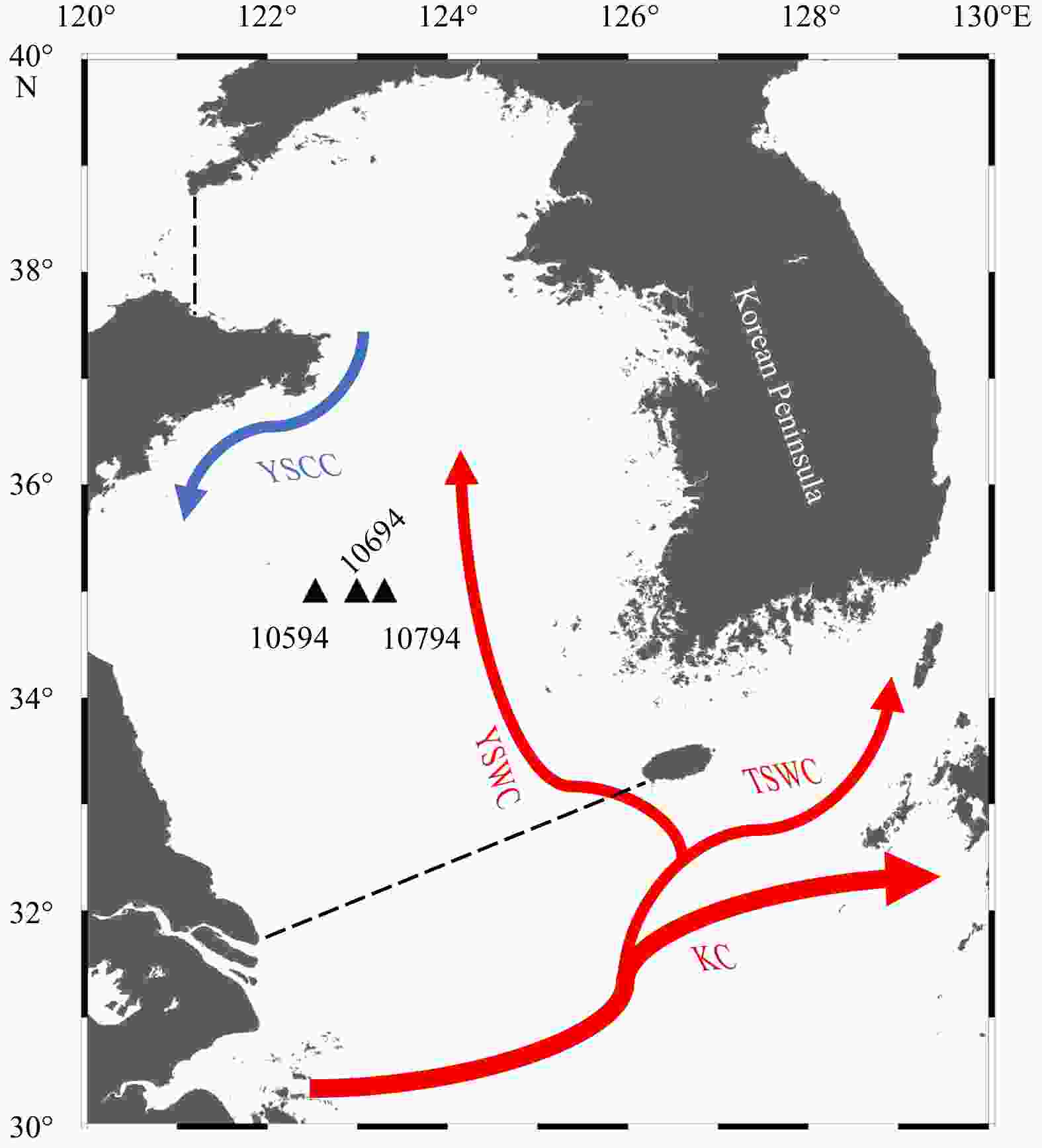
 下载:
下载:

